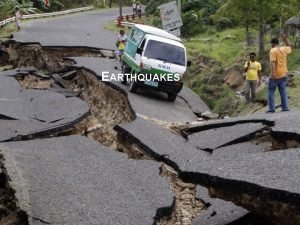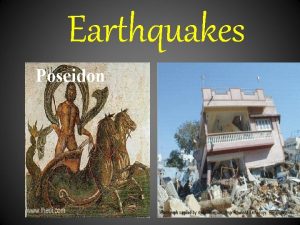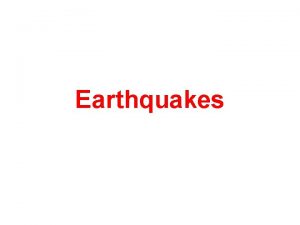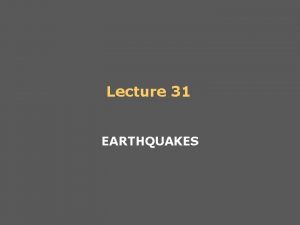Impacts of earthquakes Primary Impacts immediate effect of









- Slides: 9

Impacts of earthquakes Primary Impacts (immediate effect of the ground shaking) Buildings and bridges collapse Injury and deaths Roads, railways, airports & ports damaged Electricity cut off Gas pipes break – leaks, cut off, Telephone poles & cable destroyed – break down in communications Underground water & sewage pipes broken – leaks, cut off Secondary impacts CAN trigger landslides & tsunamis = more damage, injuries & deaths Leaking gas = fires People homeless Psychological problems Shortage of clean water, sanitation – disease spreads Roads blocked/destroyed – aid and emergency vehicles can’t get through Businesses damaged/destroyed = unemployment

Impacts of earthquakes more severe in LEDCs More poor quality housing – less stable so falls down Infrastructure is poorer – poor quality roads harder for emergency services to get to injured people = more deaths No money for protection – can’t earthquake proof buildings (rubber shock absorbers) Not enough money or resources – food, water, emergency services – to react immediately so more affected by secondary impacts Healthcare often worse. Hospitals not enough supplies so more die from treatable injuries People keep living in earthquake areas – why? Always lived there – don’t want to leave family/friends Employed there Confident of support from government if needed (rebuild homes) Think it won’t happen Too poor to have any choice

Reducing the impacts of earthquakes Prediction – impossible to predict! But there are clues – lots of small tremors, cracks, strange animal behaviour. CAN predict where they MIGHT happen – data, mapping = preparation for impacts Building techniques – buildings can be designed to withstand quakes – reinforced concrete, special foundations = reduced number of collapsed buildings = less injuries, deaths, homeless, unemployed Planning – avoid building in earthquake areas = reduced number buildings destroyed. Firebreaks reduce spread of fire. Train and prepare emergency services by practising rescues/stockpiling medicines – reduces deaths. Governments plan evacuation routes – get people out safely & quickly – reduces death and injuries Education – governments/organisations educate people about what to do (stand in doorway, go under tables) how to evacuate = less deaths. Teach how to make survival kit – food, water, torch, radio, batteries etc. = reduction in deaths Aid – LEDCs receive aid from governments/organisations – food, water, money, survival kits, people. Aid reduces impacts – find people, rebuild homes – reduces homelessness

Reducing the impacts of earthquakes – some strategies are more sustainable than others Sustainable strategies meet the needs of people today without stopping people in the future meeting their needs. Not sustainable if: - it isn’t effective (doesn’t work), expensive, harms the environment 1. Predicting is not effective = NOT SUSTAINABLE 2. Building techniques, planning, education & aid are effective, environmentally friendly – SUSTAINABLE The more cost-effective a strategy is the more sustainable it is. Good planning usually more effective than aid and it is cheaper. Some strategies are expensive (earthquake buildings) but they can be more sustainable as in the long-term less money and resources are used in rebuilding



Impacts of volcanoes Primary impacts (immediate) • Buildings and roads destroyed by lava flows and pyroclastic flows. • People and animals killed. • Crops damaged and water supplies contaminated by falling ash. • People, animals and plants suffocated by carbon dioxide. Secondary impacts (later on) Mudflows Fires started by lava flows. Psychological problems People left homeless Shortage of food. Shortage of safe water. Roads blocked or destroyed so. . • Businesses destroyed. • Sulphur dioxide released into the atmosphere causes acid rain. • •

Reducing the impacts of volcanoes Prediction –possible to roughly predict when an eruption will happen. Scientists monitor the signs – tiny earthquakes, escaping gas, changes in the shape of the volcano (bulges where magma has built up. Gives people time to evacuate – reduces injuries and deaths. Building techniques –buildings CAN’T be build to withsatand lava or pyroclastic flows, they can be strengthened so less likely to collapse under the weight of ash. Sometimes lava can be diverted away from buildings using barriers. This reduces the number of buildings destroyed, reduces injuries, deaths, homelessness & unemployment. Planning – avoid building in high risk areas= reduced number buildings destroyed. Firebreaks reduce spread of fire. Train and prepare emergency services by practising setting up emergency camps for homeless people Governments plan evacuation routes – get people out safely & quickly – reduces death and injuries from pyroclastic flows and mudflows Education – governments/organisations educate people about how to evacuate – gets people out of danger quickly and reduces deaths. Teach how to make survival kit – food, water, torch, radio, batteries, dustmask etc. = reduction in deaths Aid – LEDCs receive aid from governments/organisations – food, water, money, survival kits, people. Aid reduces impacts – rebuild homes – reduces homelessness

Reducing the impacts of earthquakes – some strategies are more sustainable than others Sustainable strategies meet the needs of people today without stopping people in the future meeting their needs. Not sustainable if: - it isn’t effective (doesn’t work), expensive, harms the environment 1. All of the strategies are sustainable – effective and environmentally friendly 2. Predicting eruptions needs special equipment and trained scientists which makes it expensive but if it is accurate it saves a lot of lives 3. Building techniques can be very expensive but can save money if they stop building destruction The more cost-effective a strategy is the more sustainable it is. Good planning usually more effective than aid and it is cheaper. Some strategies are expensive (building techniques) but they can be more sustainable as in the long-term less money and resources are used in rebuilding
 Five principles that encompass an interesting design.
Five principles that encompass an interesting design. Has an immediate and profound effect on a design
Has an immediate and profound effect on a design It has an immediate and profound effect on design.
It has an immediate and profound effect on design. In what section of earth do earthquakes happen
In what section of earth do earthquakes happen Btn earthquakes
Btn earthquakes Chapter 8 section 1 what are earthquakes
Chapter 8 section 1 what are earthquakes Explain natural disasters
Explain natural disasters Http://earthquake.usgs.gov/earthquakes/map/
Http://earthquake.usgs.gov/earthquakes/map/ Chapter 8 earthquakes and volcanoes
Chapter 8 earthquakes and volcanoes A large crack in the earth formed by a river or earthquakes
A large crack in the earth formed by a river or earthquakes

















